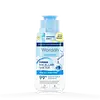What's inside
What's inside
 Key Ingredients
Key Ingredients

 Benefits
Benefits

 Concerns
Concerns

 Ingredients Side-by-side
Ingredients Side-by-side

Water
Skin ConditioningCyclopentasiloxane
EmollientIsohexadecane
EmollientDicaprylyl Carbonate
EmollientHexylene Glycol
EmulsifyingNiacinamide
SmoothingOlive Oil PEG-7 Esters
EmollientParaffinum Liquidum
EmollientSodium Chloride
MaskingPhenoxyethanol
PreservativeCyclotetrasiloxane
EmollientPrunus Amygdalus Dulcis Protein
Skin ConditioningAllantoin
Skin ConditioningCetrimonium Bromide
AntimicrobialBenzalkonium Chloride
AntimicrobialDisodium EDTA
Ethylhexylglycerin
Skin ConditioningPropylene Glycol
HumectantCucumis Sativus Fruit Extract
EmollientDecyl Glucoside
CleansingMacadamia Ternifolia Seed Oil
EmollientGlycine Soja Oil
EmollientPersea Gratissima Oil
Skin ConditioningSimmondsia Chinensis Seed Oil
EmollientParfum
MaskingBisabolol
MaskingIsobornyl Acetate
MaskingCalendula Officinalis Flower Extract
MaskingChamomilla Recutita Flower Extract
MaskingFucus Vesiculosus Extract
EmollientTriticum Vulgare Bran Extract
Skin ConditioningBHT
AntioxidantLinoleic Acid
CleansingTocopherol
AntioxidantCI 61565
Cosmetic ColorantWater, Cyclopentasiloxane, Isohexadecane, Dicaprylyl Carbonate, Hexylene Glycol, Niacinamide, Olive Oil PEG-7 Esters, Paraffinum Liquidum, Sodium Chloride, Phenoxyethanol, Cyclotetrasiloxane, Prunus Amygdalus Dulcis Protein, Allantoin, Cetrimonium Bromide, Benzalkonium Chloride, Disodium EDTA, Ethylhexylglycerin, Propylene Glycol, Cucumis Sativus Fruit Extract, Decyl Glucoside, Macadamia Ternifolia Seed Oil, Glycine Soja Oil, Persea Gratissima Oil, Simmondsia Chinensis Seed Oil, Parfum, Bisabolol, Isobornyl Acetate, Calendula Officinalis Flower Extract, Chamomilla Recutita Flower Extract, Fucus Vesiculosus Extract, Triticum Vulgare Bran Extract, BHT, Linoleic Acid, Tocopherol, CI 61565
Water
Skin ConditioningButylene Glycol
HumectantDisodium Cocoamphodiacetate
CleansingPEG-6 Caprylic/Capric Glycerides
EmulsifyingUrea
BufferingPolysorbate 20
EmulsifyingSalicylic Acid
MaskingSodium Chloride
MaskingPEG-40 Hydrogenated Castor Oil
EmulsifyingAllantoin
Skin ConditioningSodium Glycolate
BufferingCentella Asiatica Extract
CleansingLactic Acid
BufferingDMDM Hydantoin
PreservativeSodium Hydroxide
BufferingDisodium EDTA
Propylene Glycol
HumectantHamamelis Virginiana Extract
AntiseborrhoeicGlycerin
HumectantMentha Piperita Oil
Masking1,2-Hexanediol
Skin ConditioningMelaleuca Alternifolia Leaf Oil
AntioxidantCitric Acid
BufferingSodium Benzoate
MaskingPotassium Sorbate
PreservativeWater, Butylene Glycol, Disodium Cocoamphodiacetate, PEG-6 Caprylic/Capric Glycerides, Urea, Polysorbate 20, Salicylic Acid, Sodium Chloride, PEG-40 Hydrogenated Castor Oil, Allantoin, Sodium Glycolate, Centella Asiatica Extract, Lactic Acid, DMDM Hydantoin, Sodium Hydroxide, Disodium EDTA, Propylene Glycol, Hamamelis Virginiana Extract, Glycerin, Mentha Piperita Oil, 1,2-Hexanediol, Melaleuca Alternifolia Leaf Oil, Citric Acid, Sodium Benzoate, Potassium Sorbate
Ingredients Explained
These ingredients are found in both products.
Ingredients higher up in an ingredient list are typically present in a larger amount.
Allantoin is a soothing ingredient known for its protective and moisturizingg properties. Because of this, it is often added to products with strong active ingredients.
Studies show higher concentrations of this ingredient can promote wound healing.
Though it can be derived from the comfrey plant, allantoin is produced synthetically for cosmetic products to ensure purity.
Learn more about AllantoinDisodium EDTA plays a role in making products more stable by aiding other preservatives.
It is a chelating agent, meaning it neutralizes metal ions that may be found in a product.
Disodium EDTA is a salt of edetic acid and is found to be safe in cosmetic ingredients.
Learn more about Disodium EDTAPropylene Glycol is an odorless, colorless liquid. As a humectant, it helps skin retain moisture. It also aids in delivering active ingredients.
Another role of this ingredient is preventing a product from melting or freezing. Propylene glycol also adds antimicrobrial properties to a product, elongating product lifespan.
This ingredient is considered an organic alcohol and commonly added into both cosmetics and foods.
Those with sensitive skin or conditions may develop a rash when using this ingredient.
Learn more about Propylene GlycolChances are, you eat sodium chloride every day. Sodium Chloride is also known as table salt.
This ingredient has many purposes in skincare: thickener, emulsifier, and exfoliator.
You'll most likely find this ingredient in cleansers where it is used to create a gel-like texture. As an emulsifier, it also prevents ingredients from separating.
There is much debate on whether this ingredient is comedogenic. The short answer - comedogenic ratings don't tell the whole story. Learn more about comegodenic ratings here.
The concensus about this ingredient causing acne seems to be divided. Research is needed to understand if this ingredient does cause acne.
Scrubs may use salt as the primary exfoliating ingredient.
Learn more about Sodium ChlorideWater. It's the most common cosmetic ingredient of all. You'll usually see it at the top of ingredient lists, meaning that it makes up the largest part of the product.
So why is it so popular? Water most often acts as a solvent - this means that it helps dissolve other ingredients into the formulation.
You'll also recognize water as that liquid we all need to stay alive. If you see this, drink a glass of water. Stay hydrated!
Learn more about Water